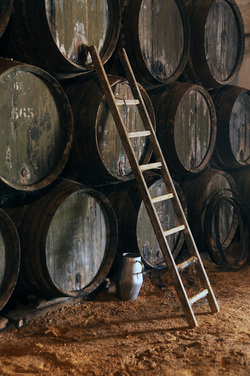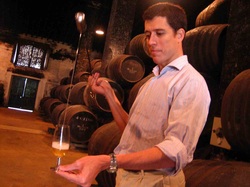|
Fino is the Prince of all wine and Manzanilla is its brother. Both are elegant, refined and dignified while remaining forceful. They are crisp, clean, and sharp on the palate. Having only tertiary flavors, they hit the senses like a ton of bricks. One’s initial reaction to the first glass is usually one of shock, as the flavors cause a sensory overload. Then, after the shock, the palate begins to appreciate the multitude of flavors and the refreshing feeling on the back palate. This is the wine that combines with the unpairables, with egg dishes, olives, pickles and every type of seafood and shellfish.  Fino de Jerez or Fino Sherry is not to be confused with wines called “fino” from other wine producing regions. For centuries wines were given type names without any control or guarantees. The word “fino” simply means refined, so that any wine that was considered as such was so-called. This has lead today to much confusion, as no current wine control organization will make one of their wines change its name. Suffice it to say that the famous “fino” is Fino de Jerez. Yet there is much confusion today with Fino from Montilla-Moriles. Although a nice wine in itself the only thing it shares with Fino de Jerez is its name. It is made from a different grape using a different process and shares none of the qualities as its namesake from Jerez.  Manzanilla shares the same process of “crianza” with Fino but has very specific differences that cause it to be a different type of wine. The first and most important difference is that, within the Sherry triange, Manzanilla can only be made in Sanlucar de Barrameida. The proximity to the sea gives the Manzanilla a saline quality that Fino does not have. Further, the greater humidity in Sanlucar causes the “flor” to be much thicker during the months of extreme temperature, protecting it better from oxidation. Therefore the biological development is different. As a result, the Manzanilla is lighter than Fino. This wine has a very different nose than fino. The reason that it is called Manzanilla is that it smells like the tea manzanilla, the Spanish name for Camomile. The rest of the process is the same for the two types of wine therefore I will refer only to Fino throughout the rest of the article.  Fino is allowed to happen. It is guided by a loving and knowing hand during its evolution, but, not withstanding it is allowed to develop as it will. Immediately after the fermentation process the “mosto” that is deemed most appropriate by the “capataz” is selected to be fino. At that time, vinic alcohol is added to the mosto in order to raise its alcohol level from its natural 12% to 15% in order to create the optimal conditions for the “flor” to grow. At this point in development it can be referred to as “sobretablas” because it is the first time that it will touch wood. It is then added to the last “criadera,” literally nursery, to begin its long development into wine.  As soon as the mosto reaches 15% alcohol a naturally occurring yeast, called “flor,” begins to grow. This is the main reason that Sherry cannot be made outside the Sherry triangle, this “flor” exists nowhere else in the world and cannot be transplanted. This yeast has a symbiotic relationship with the wine; it feeds the wine and the wine feeds it. This yeast feeds off oxygen and alcohol, keeping the wine from a natural rise in alcohol as a result of evaporation and it protects the wine from oxygenation. This allows the wine to remain a very light straw color.  The “flor” and the wine are revitalized by moving part of the wine from barrel to barrel or “rociando.” This wine movement is done once or twice a year depending on when the wine “asks” to be moved. This is a process of dynamic, fractional blending: that is, 1/3 of the content of the wine barrels in one stage is removed and added to the barrels in the next stage (criadera), as an equal fraction from that stage has been removed and added to the next, this done until one gets to the “criadera” from which the bottling takes place (called the “Solera”). The wine moves and the barrels are always stationary. The wine being moved refreshes the wine in the barrel into which it is moved and the wine currently in that barrel “educates” the new wine just added. This process allows the wine to be always ancient yet always new. It creates a wine that is consistent, and fresh and young no matter how old the “Solera,” or base wine, is.  This is a wine that speaks to those who understand how to listen to it. The “capataz” which is translated as overseer, is the man responsible for listening to the wine and seeing to it that its wishes are fulfilled. He is the man who decides when it is time to move the wine from one criadera to the other. He is the guiding hand that helps what is a natural process come to fruition. An expert capataz is one that makes, rather than a good wine, a great wine. Fino and Manzanilla, then, are a combination of wine, flor, capataz and bodega. It is the art of the capataz combined with nature, unique and non-transferable. Sui generis. Fino VS Manzanilla: Pairing the Unpairables
0 Comments
Leave a Reply. |
AuthorPeter De Trolio III Archives
April 2013
CategoriesAbout the Author
|


 RSS Feed
RSS Feed
